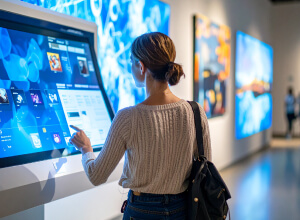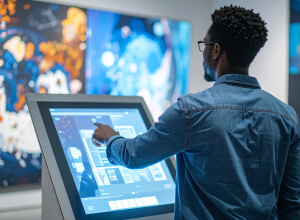How Long Does It Take to Build an Interface for a Touch Screen Display?

Uncover the secrets to building a touch screen display interface quickly and easily. Learn how complexity and tools like Intuiface can impact development time.
In today's fast-paced digital world, the demand for interactive touch screen displays is growing rapidly across various industries. From retail and hospitality to corporate environments, these displays offer a modern and engaging way to interact with users. A question we often hear is, "How long does it take to build an interface for a touch screen display?" The short answer is—it varies. This blog post will explore the factors that influence the time required to create an effective, user-friendly touch screen interface.
Impact of Project Complexity
The time required to develop a touch screen interface varies significantly based on its complexity. For instance, a simple image browser that displays basic information or menus can be developed relatively quickly. These low-complexity projects have straightforward functionalities and minimal interactive elements, which streamline development.
In contrast, projects with high interactivity, such as endless aisle kiosks in retail stores, demand more time and resources. These complex projects often feature advanced functionalities like real-time inventory tracking, detailed product information, and integrated payment systems. Each of these elements adds layers of complexity that extend the development timeline.
Additional features in complex projects, such as order processing, real-time data updates, multi-touch capabilities, and seamless integration with other systems, further increase the time required for development. Orchestrating these intricate functionalities ensures a smooth user experience but demands careful planning, extensive testing, and rigorous debugging, all of which impact the overall delivery schedule.
Custom Coding vs. Using Intuiface
Teams must decide whether to develop a touch screen interface from scratch using code or employ software like Intuiface to facilitate the delivery process. Understanding the key differences between these two approaches is essential.
Custom coding involves using programming languages such as HTML, CSS, JavaScript, and various frameworks to build an interface tailored to your specific needs. This method grants absolute control over every aspect of the design and functionality, permitting the creation of nearly any feature one can imagine. However, this level of customization and flexibility comes with a significant investment of time and expertise, often requiring an extended development timeline, specialized knowledge, and unpredictable long-term costs.
On the other hand, software solutions like Intuiface provide a faster and more streamlined approach to creating touch screen interfaces. With drag-and-drop functionalities and intuitive design environments, these tools significantly reduce the time and technical skills needed to produce a polished, user-friendly display. While such software might impose certain limitations on customization compared to custom coding, it can still offer a broad range of functionalities suited for most applications, from informational displays to interactive kiosks.
Choosing between these options depends on your project's specific requirements and constraints. If you need a highly specialized interface with unique features and have access to skilled developers with the necessary time to dedicate to the project, custom coding might be the more suitable path. However, if speed to market, ease of use and cost-efficiency are top priorities, leveraging software like Intuiface will likely be the preferred choice. This approach allows organizations to rapidly deploy effective touch screen solutions without the extensive development overhead inherent in custom coding.
Read Case Study : DIY In-Store Interactive Kiosks Using Intuiface
.png)
Average Time to Build an Interactive Interface for Touchscreens
While there is no one-size-fits-all answer, a general rule of thumb is that projects requiring limited interaction typically take one to two months to build and test if written in code and about one week if created with software like Intuiface. This timeframe includes the initial design, development, user testing, and necessary revisions.
However, if the interactive experience is more lengthy and complicated or requires unique, custom-built elements, the custom coding process can take substantially longer. For example, a touch screen display for a high-end retail store that includes features like virtual try-ons or personalized recommendations could take months. Meanwhile, with software like Intuiface, time savings approach 80% of the custom coding timeline. The trade-off with tools like Intuiface could be some restriction of feature scope depending on the complexity of the project specs.
In conclusion, the time to build a touch screen display interface varies depending on the team's skills and the project's complexity. By understanding these factors, business owners and project managers can better estimate timelines and set realistic expectations. Interested in creating an engaging touch screen interface for your business? Reach out to our expert team today to get started!
Read also Interactive Museum Displays, Exhibits & Technology
.png)





